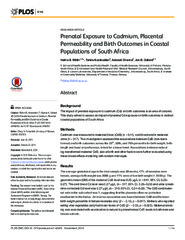Prenatal exposure to cadmium, placental permeability and birth outcomes in coastal populations of South Africa
Permanent lenke
https://hdl.handle.net/10037/8638Dato
2015-11-06Type
Journal articleTidsskriftartikkel
Peer reviewed
Sammendrag
Methods Cadmium was measured in maternal blood (CdB) (n = 641), cord blood and in maternal urine (n = 317). This investigation assessed the associations between CdB (non-transformed) and birth outcomes across the 25th, 50th, and 75th percentile for birth weight, birth length and head circumference, to test for a linear trend. Associations between natural log-transformed maternal CdB, size at birth and other factors were further evaluated using linear mixed-effects modelling with random intercepts.
Results The average gestational age in the total sample was 38 weeks; 47% of neonates were female, average birth weight was 3065 g and 11% were of low birth weight (< 2500 g). The geometric mean (GM) of the maternal CdB level was 0.25 μg/L (n = 641; 95% CI, 0.23– 0.27). The cord blood Cd level was 0.27 μg/L (n = 317; 95% CI, 0.26–0.29) and urine (creatinine-corrected) Cd level was 0.27 μg/L (n = 318; 95% CI, 0.24–0.29). The CdB cord:maternal ratio in the sub-cohort was 1, suggesting that the placenta offers no protective mechanism to the foetus. An inverse association was found between CdB and the lower birth weight percentile in female neonates only (β = - 0.13, p = 0.047). Mothers who reported eating vine vegetables daily had lower levels of CdB (β = - 0.55, p = 0.025). Maternal smoking was associated with an elevation in natural log-transformed CdB levels in both male and female cohorts.
Discussion Significant inverse associations between prenatal Cd exposure and birth anthropometry were found in female neonates but not in male neonates, suggesting potential sex differences in the toxico-kinetics and toxico-dynamics of Cd.


 English
English norsk
norsk